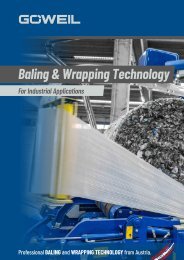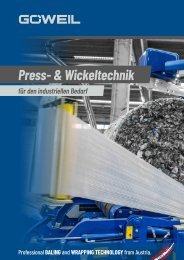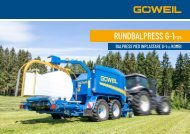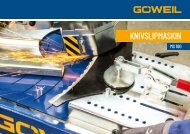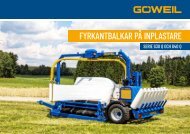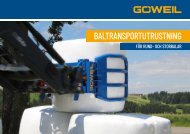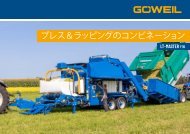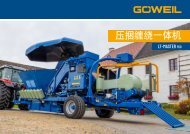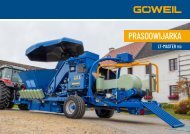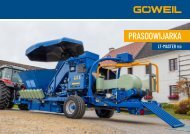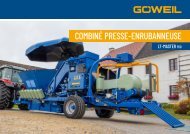Farm Machinery Journal - G-1F125 Kombi
The Farm Machinery Journal from England, pays a visit to one of our customers and talks to them about their GÖWEIL G-1 F125 Combi
The Farm Machinery Journal from England, pays a visit to one of our customers and talks to them about their GÖWEIL G-1 F125 Combi
You also want an ePaper? Increase the reach of your titles
YUMPU automatically turns print PDFs into web optimized ePapers that Google loves.
Front Link<br />
First Impression // Göweil G-1 F125 <strong>Kombi</strong><br />
Austrian<br />
oddity<br />
The Göweil G-1 F125 <strong>Kombi</strong> is a rare machine in the UK, but that shouldn’t stop farmers and<br />
contractors taking a closer look. FMJ went to see the first example to land here<br />
WORDS AND IMAGES KEN TOPHAM<br />
hile combi balers are not<br />
a rare sight, here in the UK<br />
W<br />
the Göweil G-1 F125 <strong>Kombi</strong> is.<br />
In fact, the example here is the first<br />
and currently the only G-1 F125 sold<br />
by Göweil in the UK, excluding any<br />
used imports.<br />
Father and son Ian and Richard<br />
Lennie are contractors and farmers<br />
based near Chester who took the<br />
plunge after owning a previous<br />
Göweil (pronounced Gu-vile) baler<br />
and wrapper unit. And although<br />
Richard had a few bumps in the road,<br />
“A technician was<br />
on a plane first thing<br />
the next day. You<br />
can’t ask for more”<br />
it was Göweil ‘s customer service that<br />
ultimately sealed the deal on this<br />
machine. With no actual dealers in<br />
the UK to date, many would question<br />
why you would buy a baler from<br />
Göweil, but Richard and his dad Ian<br />
took a well-hedged bet on the<br />
Austrian firm.<br />
Ian Richard had already owned a<br />
Göweil wrapper frame with a Welger<br />
RP baler in it, which was lost to fire<br />
of the baler, and also a previous<br />
generation Göweil combi baler. “The<br />
first combi from Göweil we bought<br />
in 2016 had a few niggles,” explains<br />
Richard. “Always silly things, which<br />
was frustrating, but the factory were<br />
so good with back-up we weren’t<br />
worried. We had a breakdown once<br />
that we couldn’t fix and a technician<br />
was on a plane first thing the next<br />
day. You can’t ask for more.”<br />
When it came down to<br />
replacement, Richard briefly looked<br />
at a Kuhn, but having dealt directly<br />
with Göweil before, the Austrian<br />
manufacturer agreed to sell and<br />
provide back-up to a G-1 F125. The<br />
machine was actually ordered in<br />
2020 but arrived in<br />
time for the 2021<br />
grass season. “The<br />
only concern we<br />
had was secondhand<br />
value, but we don’t intend to<br />
change brand,” says Richard.<br />
“Technical support has been very<br />
good and there’s a WhatsApp number<br />
for parts. You can take a picture of<br />
the part you need and they UPS it<br />
overnight. It’s a brilliant system”.<br />
Baler and wrapper<br />
The G-1 is a 125cm fixed chamber baler<br />
with crop cutting and plastic or net<br />
binding. It has a dual orbit wrapper<br />
element at the rear. Ahead of the<br />
chamber is an upward feed of crop<br />
over the 570mm-diameter, six-point<br />
rotor through the bank of 30 knives,<br />
which is combined with the drop floor,<br />
or pop floor as it should perhaps be<br />
known given that it goes up not down.<br />
Either way, it allows blockages to pass,<br />
taking the knives out of work position<br />
and automatically resetting itself<br />
when the lump has passed.<br />
TECHSPECS<br />
Göweil G-1<br />
F125 <strong>Kombi</strong><br />
Header 2.2m, six<br />
rows of tines<br />
Chopping 30<br />
double-sided<br />
knives<br />
Chamber 18 rollers,<br />
fixed<br />
Binding Net or<br />
full-width plastic<br />
Wrapper Twin orbit,<br />
750mm rolls<br />
Width 3.0m<br />
(standard tyres)<br />
Weight 8980kg<br />
Power requirement<br />
160hp<br />
Hydraulic requirement<br />
Min 80L/min (load<br />
sensing)<br />
APRIL 2022 WWW.FARMMACHINERYJOURNAL.CO.UK
Left: A monitor<br />
and two cameras<br />
are standard on<br />
the Göweil baler<br />
Right: The Göweil<br />
features plastic bands<br />
and six rows of tines,<br />
so should give a clean<br />
and quiet sweep<br />
Left: The G-1 is<br />
ISObus controlled<br />
and a stand-alone<br />
screen is available<br />
if your tractor is<br />
not compatible<br />
Right: Two crop<br />
press rollers and a<br />
hydraulically driven<br />
feed roller give a good<br />
feed with little room<br />
for bridging<br />
The knives are below the binding<br />
system and can be changed without<br />
tools or opening the chamber, or<br />
crawling around underneath. The<br />
knives are reversible and give a<br />
35mm theoretical chop length.<br />
Richard gives those on his baler a<br />
touch-up every 1000 bales so they<br />
don’t dull easily. The crop flow would<br />
see the knives working in the top of<br />
the swath, as it’s lifted by the pick-up<br />
rather than the bottom, so soil or<br />
stone contamination may play a<br />
factor in how long the edge lasts.<br />
Before the rotor is the 2.2m header,<br />
which looks well engineered and has<br />
a pendulum action to follow the<br />
ground. This allows each<br />
wheel to lift by 150mm<br />
without causing the<br />
opposite wheel to lift off.<br />
The jockey wheel arms<br />
wouldn’t look out of<br />
place on a plough. The<br />
roller crop press is equally<br />
well built with sealed<br />
bearings at either end of the<br />
double roller press. Behind that is<br />
a hydraulically driven feed roller and<br />
short augers to push crop in from the<br />
sides of the header. It’s all tightly<br />
arranged and Richard says the feed is<br />
good even in shorter crops, as there<br />
is little space for bridging.<br />
Above inset:<br />
Owner-operator<br />
Richard Lennie<br />
quickly dismissed<br />
more established<br />
brands in favour<br />
of another Göweil<br />
The pick-up is an area where<br />
Richard has seen great<br />
improvement. “With our old<br />
baler we did some work with<br />
Göweil on the tines. We did<br />
have some trouble with<br />
breaking tines and<br />
experimented with different<br />
angles, but we have only broken<br />
a handful on the new machine,” he<br />
says. Also Göweil adopted a plastic<br />
tine band that has worked very well.<br />
“We do have some meadowland that<br />
has some sharp undulations, and if<br />
you’re not careful it can cause the<br />
pick-up to bottom out. This would<br />
bend steel bands but the plastics just<br />
“It’ll make a good bale in<br />
pretty much any crop”<br />
WWW.FARMMACHINERYJOURNAL.CO.UK APRIL 2022
Front Link<br />
First Impression // Göweil G-1 F125 <strong>Kombi</strong><br />
pop back. It’s also much quieter and<br />
easier if you need to replace a tine,<br />
as they flex out of the way easily.”<br />
Inside the 18-roller chamber is a<br />
starter roller and above it a cleaner<br />
roller with a scraper. Richard doesn’t<br />
report any slippage in straw so the<br />
cleaner roller surface must keep it<br />
moving, the only drawback being<br />
that when working in straw the<br />
baler will roll the bale for a number<br />
of revolutions when the net is cut.<br />
“It’s not long, but all day it adds up,”<br />
Richard explains. “We’re hoping they<br />
can change the preset as it seems too<br />
long to me, but it’s only a minor thing<br />
really.<br />
Above and above<br />
right: The wrapping<br />
element is well<br />
proven, available as a<br />
frame for other balers<br />
as well as being part<br />
of development for<br />
another manufacturer<br />
Left: The Göweil can<br />
be fitted with any<br />
hitch. Adjustment for<br />
setting the drawbar<br />
to get the baler level<br />
is straightforward<br />
Above: Reloading the<br />
wrapper is a convenient<br />
job, done without lifting<br />
anything much above<br />
waist height<br />
Above centre: The chamber has a<br />
starter roller behind the rotor to<br />
get the bale turning and cleaner<br />
roller above to keep debris from<br />
clogging the other rollers<br />
“Bale density is good,” he continues.<br />
“It’ll make a good bale in pretty much<br />
any crop. We’ve made some plastic<br />
on plastic-bound bales for customers<br />
who wanted to see what they were<br />
like and the feedback has been very<br />
good.” Richard’s own bales have been<br />
very good, which has given him and<br />
Ian the confidence to recommend<br />
plastic binding to customers.<br />
Pay attention<br />
One of the few niggles Richard has<br />
found with the G-1 has been using<br />
plastic to bind the bale in dry crop.<br />
“You just have to pay attention when<br />
the film goes in,” he says. “Every now<br />
and then it won’t catch the bale and<br />
you end up not tying, which means<br />
digging the bale out if you miss it,”<br />
he continues, explaining that you<br />
can see the plastic going into the<br />
chamber on the camera and if the<br />
auto-tie misses and you spot it you<br />
can manually re-tie the bale. But, he<br />
adds, you have to be quick as the<br />
binding gets wrapped on a chamber<br />
roller. It’s not a common occurrence<br />
but in very dry grass it can happen.<br />
The wrapping element is well<br />
polished, Göweil having developed<br />
bale transfer and wrapping units for<br />
their own frame that houses other<br />
manufacturers’ balers. They have<br />
also developed the system used by<br />
another major manufacturer who<br />
offers a combi baler in this format.<br />
APRIL 2022 WWW.FARMMACHINERYJOURNAL.CO.UK
Front Link<br />
First Impression // Göweil G-1 F125 <strong>Kombi</strong><br />
Richard says in optimal conditions<br />
a rate of 60 bales per hour is a good<br />
output.<br />
Plastic consumption with six layers<br />
provides 40 bales per pair of 750mm<br />
rolls, and binding plastic sees around<br />
140 bales per roll. “It’s a pound per<br />
bale more for plastic binding,”<br />
clarifies Richard. “With net you can<br />
bind twice as many bales per roll.”<br />
The storage on the Göweil is well<br />
laid out with seven rolls of wrap<br />
each side and space for a roll<br />
of net wrap or plastic in<br />
each store. The binding<br />
plastic has adjustment<br />
for stretch but Richard<br />
says he’s not tested the<br />
idea of applying less<br />
wrap on bales that are<br />
bound with plastic. “In<br />
theory you could apply<br />
less, but we wanted to see<br />
how customers liked the<br />
plastic binding before we got<br />
too clever, and how the bales<br />
stored too.” Silage quality is the<br />
main reason for plastic binding,<br />
but recycling is also easier as the<br />
products can be processed together.<br />
Clever connection<br />
The drawbar on the G-1 has a forage<br />
wagon-like look about it. An optional<br />
extra sees hydraulic cylinders fitted<br />
to the pivot point, the aim being<br />
easier entry into steep gateways,<br />
enabling the operator to raise or<br />
lower the front to stop the tail or<br />
pick-up grounding out. It’s a useful<br />
feature for this format of combi<br />
baler, as they are inherently low<br />
to the ground.<br />
The control interface is ISObus<br />
connected and Richard runs his<br />
through the New Holland T7<br />
IntelliView IV screen. It controls the<br />
G-1 and displays progress information<br />
for the wrapper and baler status.<br />
Above: The header<br />
wheels are<br />
substantially mounted<br />
and each wheel can<br />
rise by 150mm via the<br />
pendulum movement<br />
of the header<br />
Above: The T7.185 is a good match<br />
for the G-1 F125 and the<br />
AutoCommand transmission<br />
makes the day go by a little easier<br />
Left inset: External controls for<br />
opening the wrap store also<br />
allow manual control of the<br />
wrapper system<br />
Right: These cylinders allow the<br />
operator to lift or lower the front<br />
of the baler, with threaded<br />
adjusters for correct working<br />
height<br />
As with most balers, running is<br />
autonomous, only needing to stop<br />
for the chamber to open. The camera<br />
monitor supplied with the baler has<br />
two standard cameras looking at<br />
the binding material entering the<br />
chamber and the wrapper to monitor<br />
transfer and wrapping.<br />
Richard and Ian completed their<br />
first season by making over 7000<br />
bales with the G-1 F125 and are<br />
pleased with its performance and<br />
communication with the factory.<br />
Having had no warranty calls, the<br />
Göweil baler was cleaned down<br />
and parked for winter after a season<br />
without needing any technical<br />
support. Soon it’ll be getting ready<br />
for another busy season.<br />
The Austrian-built machine is a<br />
rare sight on UK shores, however as<br />
the south-east-based Cooney Furlong<br />
<strong>Machinery</strong> Company is handling the<br />
brand in Ireland, perhaps Göweil has<br />
gone straight for the combi baler<br />
jugular before we see a UK dealer,<br />
which we’re told is on the horizon.<br />
“We wanted to see how<br />
customers liked the<br />
plastic binding before<br />
we got too clever”<br />
WWW.FARMMACHINERYJOURNAL.CO.UK APRIL 2022




